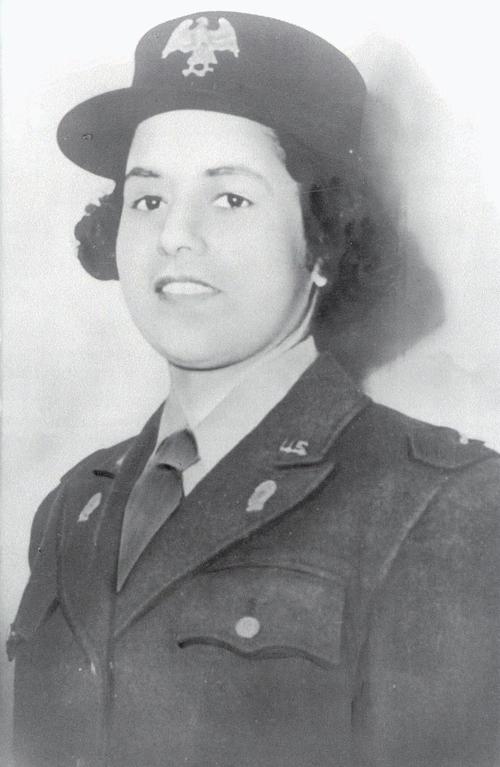On Feb. 7, 1944, First Lt. Anna Mac Clarke marched onto the grounds of the Douglas Army Air Field in Southeast Arizona with her unit of Women’s Army Corps recruits. She was a long way from her rural Kentucky home and had served on numerous bases since her enlistment in 1942.
During her short time in Arizona, Anna would make a national name for herself and change the course of history for Black soldiers — women and men — throughout the country.
Born in Lawrenceburg, Kentucky, on June 20, 1919, Anna was brought up by her grandmother after her mother died, leaving not only Anna but 3 additional half-siblings in the care of the elderly woman.
She graduated from Lawrenceburg High School in 1937 and attended Kentucky State College (now Kentucky State University) graduating in 1941 with degrees in sociology and economics. Always an active child with some even calling her a tomboy, she remained so during her college years, not only participating in sports but joining a sorority and working on the school newspaper. She earned her way through school with jobs in the Dean of Women’s office and as an assistant to one of the dorm housemothers.
After college, Anna found most businesses closed to Black females. She took a few low-paying positions but felt she was wasting her education. As World War II heated up, Anna enlisted in the Women’s Army Auxiliary Corps in 1942. The WAAC became the Women’s Army Corps in 1943.
Anna’s training started at Fort Des Moines, Iowa, which became the largest WAAC training facility for Black recruits. Completing her basic training, Anna almost immediately entered the WAAC Officer Candidate School, becoming the only female Black officer to graduate.
Fort Des Moines was still a segregated base when Anna graduated from OCS and although she and other Black officers lived on officers row, they were denied access to the officers club and the swimming pool except for one hour on Friday evenings just before the pool was cleaned.
In February 1943, Anna became a platoon leader, the first Black WAAC to command an all-white unit. She served on several posts around the country that year but when the WAAC transitioned to the WAC in September 1943, Anna was back at Fort Des Moines. Receiving a commission as first lieutenant she became part of the effort to abolish the establishment of all-Black regiments on the base.
By January 1944, Anna was in California readying a Black WAC unit for detail to Arizona’s Douglas Army Air Field, established just two years earlier and one of the busiest air fields in the state. Arriving in the desert that February, Anna and her team performed duties ranging from clerical work to aircraft maintenance. Whatever they were called to do, they handled it effortlessly and skillfully. Base commander, Col. Harvey F. Dyer, was so pleased with their work that he asked for additional WAC recruits to be sent to the air field.
The base had a movie theater for the enjoyment of the soldiers although Black soldiers, regardless of rank, were relegated to the “Negro corner” of the theater.
Having already opened doors for Black soldiers in Des Moines, Anna set off for the theater with a handful of WACs expecting to occupy any seat she wished. As she made her way into the theater, Anna was confronted by the manager who insisted Anna and her friends remain in the segregated section.
Anna argued that as a soldier in the U.S. Army, she had the same privileges as any other military man or woman regardless of the color of her skin. Management insisted but Anna knew her rights.
She reported the offense to her commanding officer and eventually found herself standing before Col. Dyer arguing that she and her recruits be afforded the same rights and considerations as white soldiers. Dyer was not about to let one of his best officers be deprived a privilege afforded every White individual in the military.
On February 21, 1944, Dyer issued orders that all military enlistees, regardless of their race, “are entitled to all the courtesies and privileges extended to white officers ... and white enlisted men and women.”
“No discrimination will be condoned,” his directive continued. Dyer pointed out that as “citizens of the United States, imbued with a spirit of patriotism which prompted them to enlist in the Women’s Army Corps as their contribution toward the war effort ... they are proud to serve their country (and) ... deserve our greatest respect.”
Newspapers across the country picked up on the story of the woman WAC who defied segregated dictates and urged an initiative to end discrimination in the military. Anna was on course to become a valued Army officer who would make a difference in desegregating military posts across the country. Her future seemed assured.
Just a month after the theater incident, Anna felt ill and checked into the post hospital. She survived the operation to remove her ruptured appendix but gangrene had set in.
Initially, she seemed to be recovering but by mid-April her condition worsened. Anna died April 19, 1944 at the age of 24.
One of her stepbrothers, a military man, escorted her body back to Lawrenceburg. When he arrived at the train station, he was ordered to take Anna’s casket through the “Colored” door at the train station.
Anna Mac Clarke’s life was cut tragically short and one must speculate what she could have achieved had she lived a full life.
She is remembered today with a historical marker at the County Courthouse in Lawrenceburg that cites the “firsts” she accomplished in her few short years and the difference she made in the lives of so many Black soldiers. She is eulogized in Chautauquan performances as well as in an award-winning play, “The Colored Door at the Train Depot,” based on her life.





